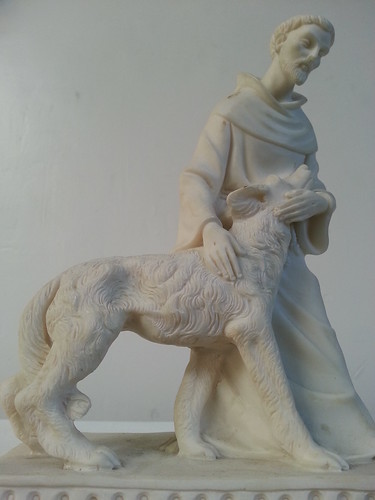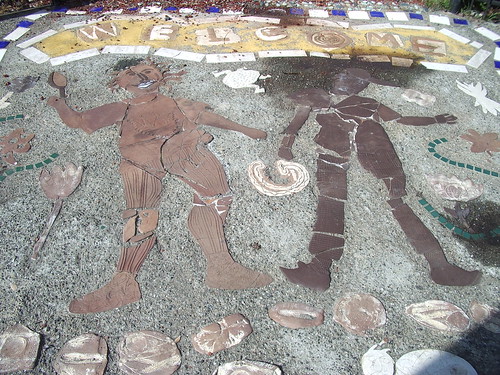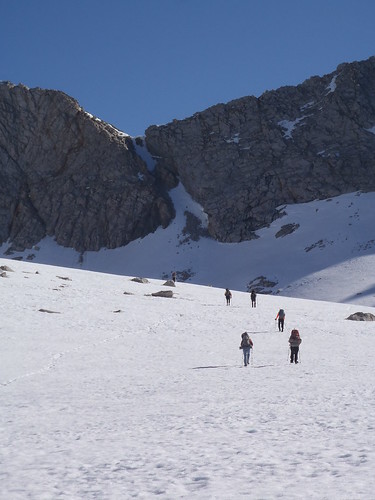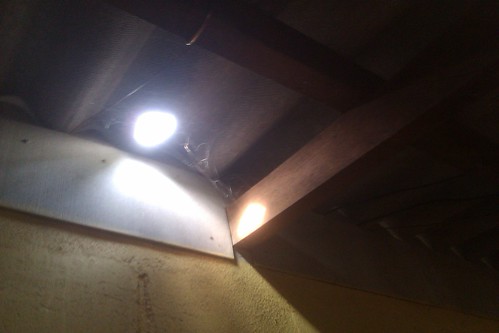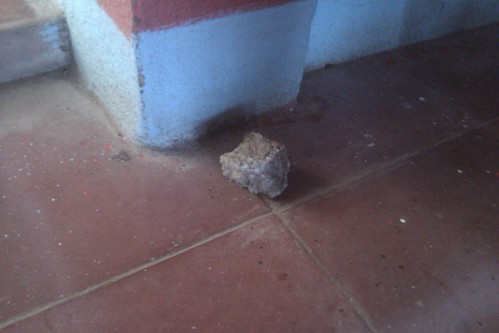The Faithful Fools’ monthly Street Retreat in October coincided
with a big bike and skateboard competition held in the Civic Center Plaza, just
outside the Tenderloin. I marveled some at the huge jumps and fancy tricks the
competitors were making on the several-ton dirt mounds trucked in for the
event, but more at how the spectacle drew flocks of young men on their own
bikes and skateboards to the City’s center. The big open walk in front of the
library was covered with boys and men rolling, jumping, flipping, and sliding
their boards back and forth across the usually empty space, pausing briefly for
any patrons who chose that entrance over the building’s other, quieter options.
Seeing public space being used by people felt good to me, as did the dynamic
energy of the skaters in contrast to the quiet stillness inside the place of
research and knowledge – a community thrives on both kinds of energy.
After a few minutes my moment of appreciation was shattered
by an altercation on the sidewalk just a few feet away: A woman waiting for the
bus was shouting “watch your language, there are children here!” as a group of
young men and a young woman carrying a blanket were calling each other names as
they walked parallel down the street. Big events, which bring noise and crowds
downtown and occupy grass and other usually quiet space, tend be stressful for
those who spend most or all of the day out on the streets. The young men, who I couldn’t hear, were
holding a cell-phone up to record the woman as she screamed at them. The words
she was using were foul! I had met her twice before, so I called her name and
approached her. I said “this isn’t helping” and stepped in between her and the
group of men. I told her I thought no one deserved to be called the names she
was using. “Yeah, but they’re so mean” she responded, “they were making fun of
my legs!” - which were bare under her short skirt, and covered with sores.
The young men walked on down the street as she and I started
talking, and then we walked together around the corner. We talked as we walked
about how people often lash out and insult others out of their own pain, fear,
and insecurity – I remembered doing so as a teenager. I waited outside of
Burger King as she went in to get some food, and then we went to find a place
to sit. She wanted to go somewhere quiet, away from all the people, and led me
to a parking lot behind a hotel, where she laid out her blanket like for a
picnic behind one of the parked cars. We had a pleasant conversation, and she
offered me some of her food. She told me a bit of the story of her coming to
San Francisco, and how she ended up staying because “you can get any drug you
want here.” I asked her about the focus of her life, which she said was getting
high.
Welcome and the Faithful Fools are both organizations that
tend to follow what’s called the “Harm Reduction Model.” This model recognizes
that, while there are some individuals who respond to themselves or their
behavior being judged by trying to change, and others who might never change
their behavior, there are others who will accept help from those who accept
them for who they are and what they do, and it is worthwhile reducing the harm
in their lives. This is the principle behind needle exchanges, the “Housing
First” model of addressing homelessness that San Francisco and other cities
have turned to in the past few years, and Welcome’s policy of providing food
and hospitality to anyone, as long as they are not presently a threat to
themselves or others. Harm Reduction is grounded in the foolish idea that
everyone is worthy of being helped, and that no one knows better than a person
themselves what help they need. What a relief it is not to have to be an
expert!
Not forgetting the altercation in front of the library, I
asked my friend about her legs: How were they? Did they need medical treatment?
Had she sought treatment yet? In addition to the scabs I had noticed, she
pointed out an open sore and a pus-filled abscess. Yes, she realized she needed
to see a doctor. I asked if she would go right then, if I would go with her?
She said she would but, as I have become used to with those living with
addictions, she needed to get high first. (A hospital is a scary enough place
already, and you never know when you will get let out – a person experiencing
withdrawal symptoms is not likely to keep waiting to be seen.) She said she’d
be done fixing in ten minutes, if I’d be willing to come back for her then. I
was, and I did, but she had not been successful in administering the drug. Her
veins had deteriorated under the effect of her drug use, making IV injection
very difficult. I continued to walk away and return about every 10 minutes for
over an hour and a half, until staff from the hotel stumbled upon her and drove
her off the parking lot. She apologized for keeping me so long, and suggested
that maybe this wasn’t going to be the best time for a trip to the hospital,
after all. Having just about used up my patience for that day, I agreed, and
headed off on my way.
I walked away feeling only slightly defeated as, while we
did not successfully attend to her clear medical need, something else important
was done with that time: we were building trust in each other, and each of us
had the opportunity to show the other that we cared about each others' needs
and respected their time. This relationship building could be a first step in a
journey toward her receiving the health care she clearly needs, but it is
certainly part of the process of building the kind of network of caring for
each other that we all depend on, and which makes living in community as
neighbors worthwhile. The proposed trip to the hospital turned out to be a
fool’s errand, but as a Fool, I could see its value in my own life, and the
life of our community.
The beautiful thing to me about this kind of work is that it
doesn’t cost any money – I didn’t need to have a blanket to give, or food to
offer, or spare change in my pocket – what it required was the willingness to
give a few minutes out of my day, to allow someone else to invite me into
relationship, and to open my heart. This kind of work is available to all of us
to do, if we are willing to give ourselves the time to go on a few fool’s
errands. We can start in our own communities, or if you want to have a
supportive container in which to follow where the pathway of relationship might
lead, you can join the Faithful Fools on one of our monthly Street Retreats in
the Tenderloin. (more information online at www.faithfulfools.org/programs/street-retreats
)


